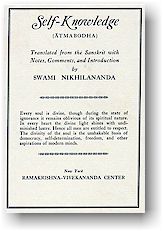| To Netnews Homepage Index |
|
228 pages 14. On account of union with the five sheaths, the pure Atman appears to be like them, as is the case with a crystal, which appears to be endowed with such colours as blue or red when in contact with a blue or red cloth. 15. One should, through discrimination, separate the pure and inmost Self from the sheaths by which It is covered, as one separates a rice-kernel from the covering husk by striking it with a pestle. 16. Though all-pervading, Atman does not shine in everything; It is manifest only in the buddhi, like a reflection in clear water or in a stainless mirror. 17. Realize Atman to be distinct from the body, sense-organs, mind, buddhi, and non-differentiated Prakriti, but the Witness of their functions, comparable to a king. 18. As the moon appears to be moving when the clouds move in the sky, so also, to the non-discriminating, Atman appears to be active when in reality the senses are active. 19. The body, senses, mind, and buddhi engage in their respective activities with the help of Consciousness, which is inherent in Atman, just as men work with the help of the light that is inherent in the sun. 20. Fools, through non-discrimination, superimpose on the stainless Atman, which is Existence and Consciousness Absolute, the characteristics and functions of the body and the senses, just as people attribute such traits as blueness and concavity to the sky. 21. As the movement that belongs to water is attributed, through ignorance, to the moon reflected in it, so also agency, enjoyment, and other limitations, which belong to the mind, are falsely attributed to Atman. 22. Attachment, desire, pleasure, pain, and the rest, are perceived to exist as long as the buddhi, or mind, functions. They are not perceived in deep sleep, when the mind ceases to exist. Therefore they belong to the mind alone and not to Atman. 23. The nature of Atman is Eternity, Purity, Reality, Consciousness, and Bliss, just as luminosity is the nature of the sun, coolness of water, and heat of fire. 24. Such a notion as "I know" is produced by the union, due to non-discrimination, of a modification of the mind with two aspects of Atman, namely, Existence and Consciousness. 25. Atman never undergoes change, and the buddhi is never endowed with consciousness. But man believes Atman to be identical with the buddhi and falls under such delusions as that he is the seer and the knower. - Sankaracharya, Atmabodha (Self-Knowledge), 14-25. Sankaracharya was born during the eighth century and renounced the world at an early age in quest of Truth. He engaged himself in reforming the Sanatana Dharma, the Eternal Religion of the Hindus, and with that end in view wrote commentaries on the Bhagavad Gita, the Brahma-sutras, and the principal Upanishads. He became the personification of the wisdom of the Vedas. He travelled the length and breadth of India, preaching the divinity of the soul and the oneness of existence. Before his death at the age of thirty-two at Kedarnath, in the Himalayas, Sankara had established monasteries at Sringeri (Mysore) in the south, Puri in the east, Dwakara (Kathiawad) in the west, and Joshi Math (the Himalayas) in the north. In Sankara one finds the unusual combination of philosopher and poet, savant and saint, mystic and religious reformer, debater of rare forensic power and passionate lover of God. Last Updated July 10, 1999 |
|
| To Netnews Homepage Index |
 Swami Nikhilananda (Translator)
Swami Nikhilananda (Translator)